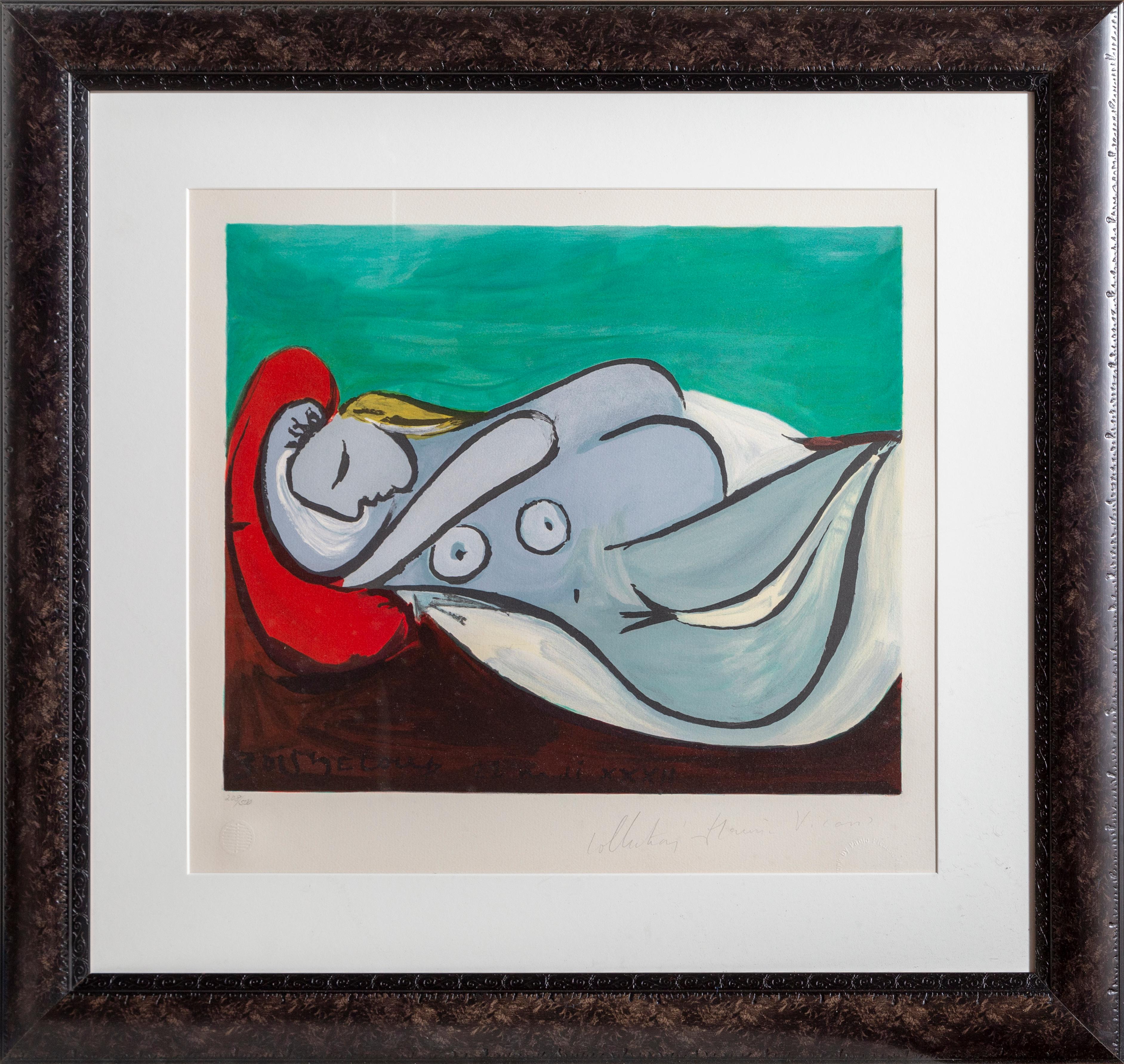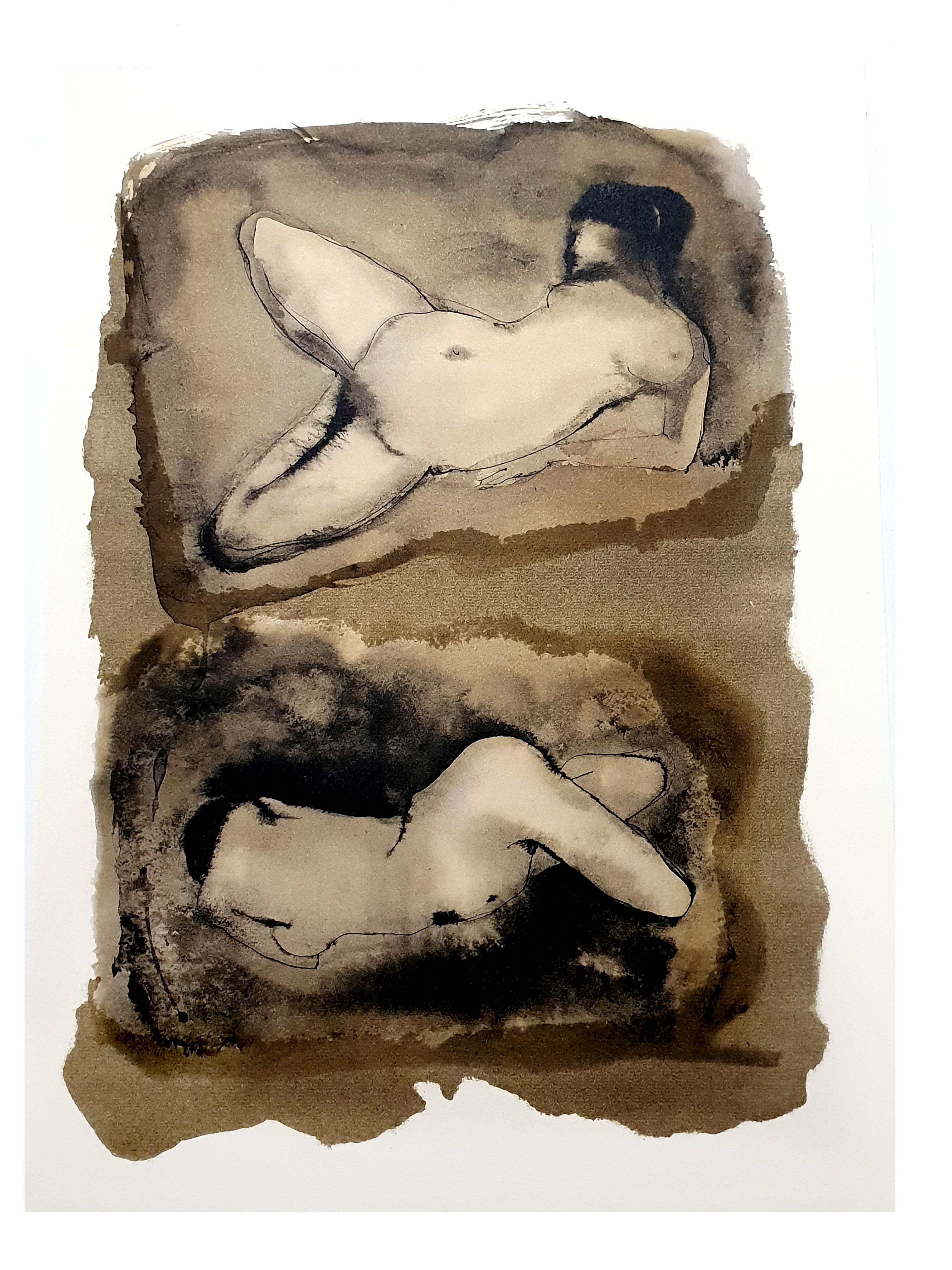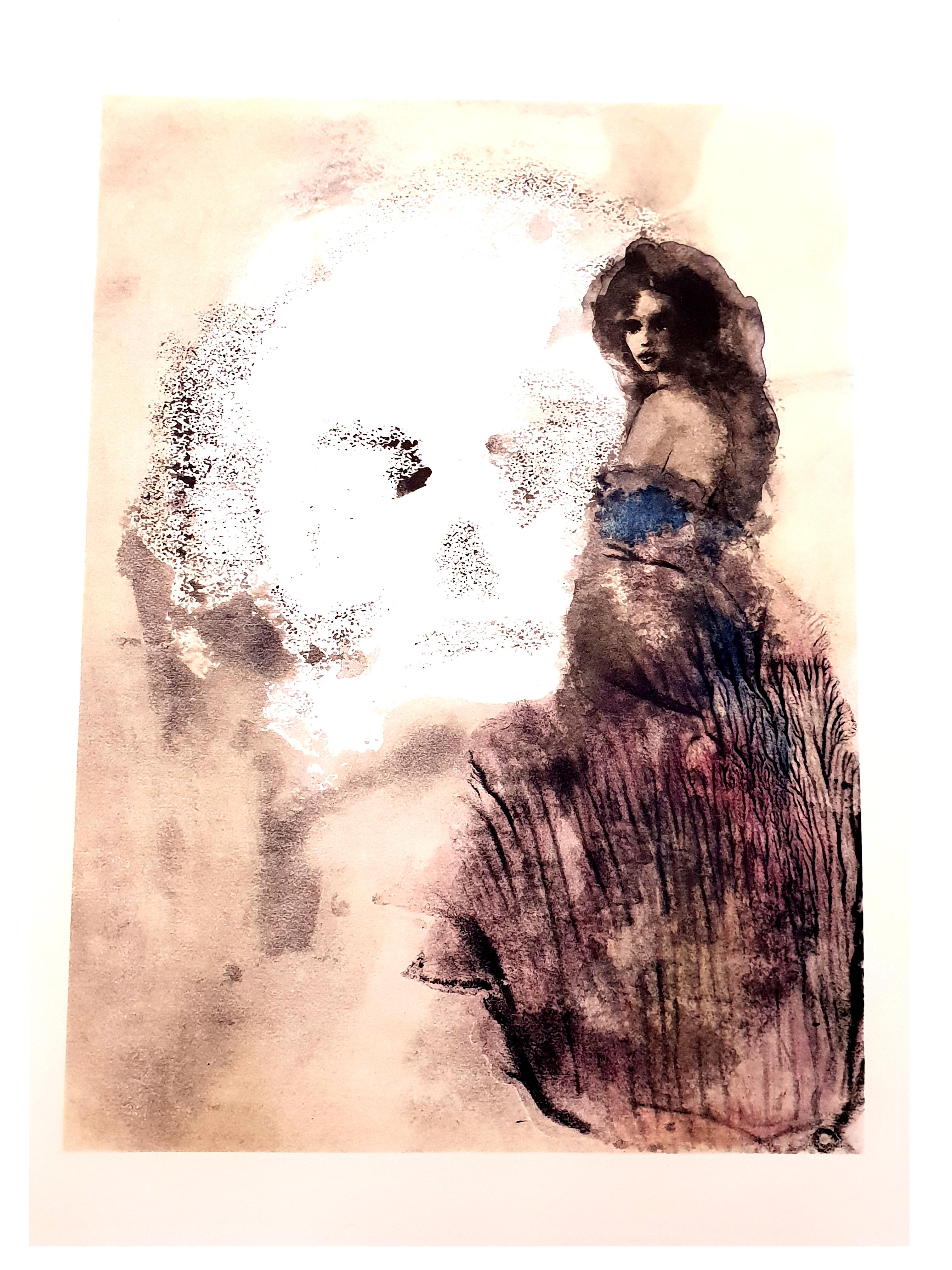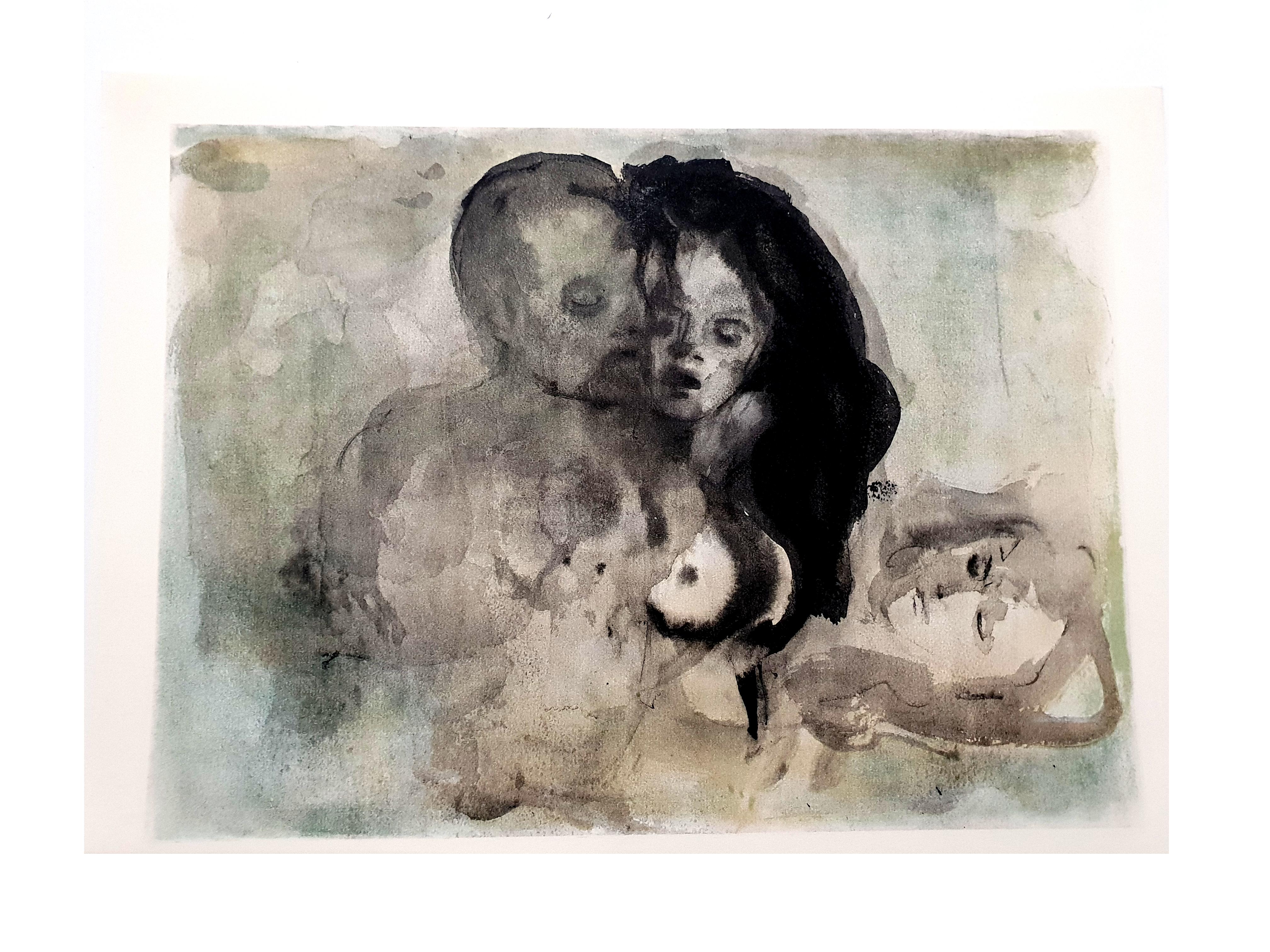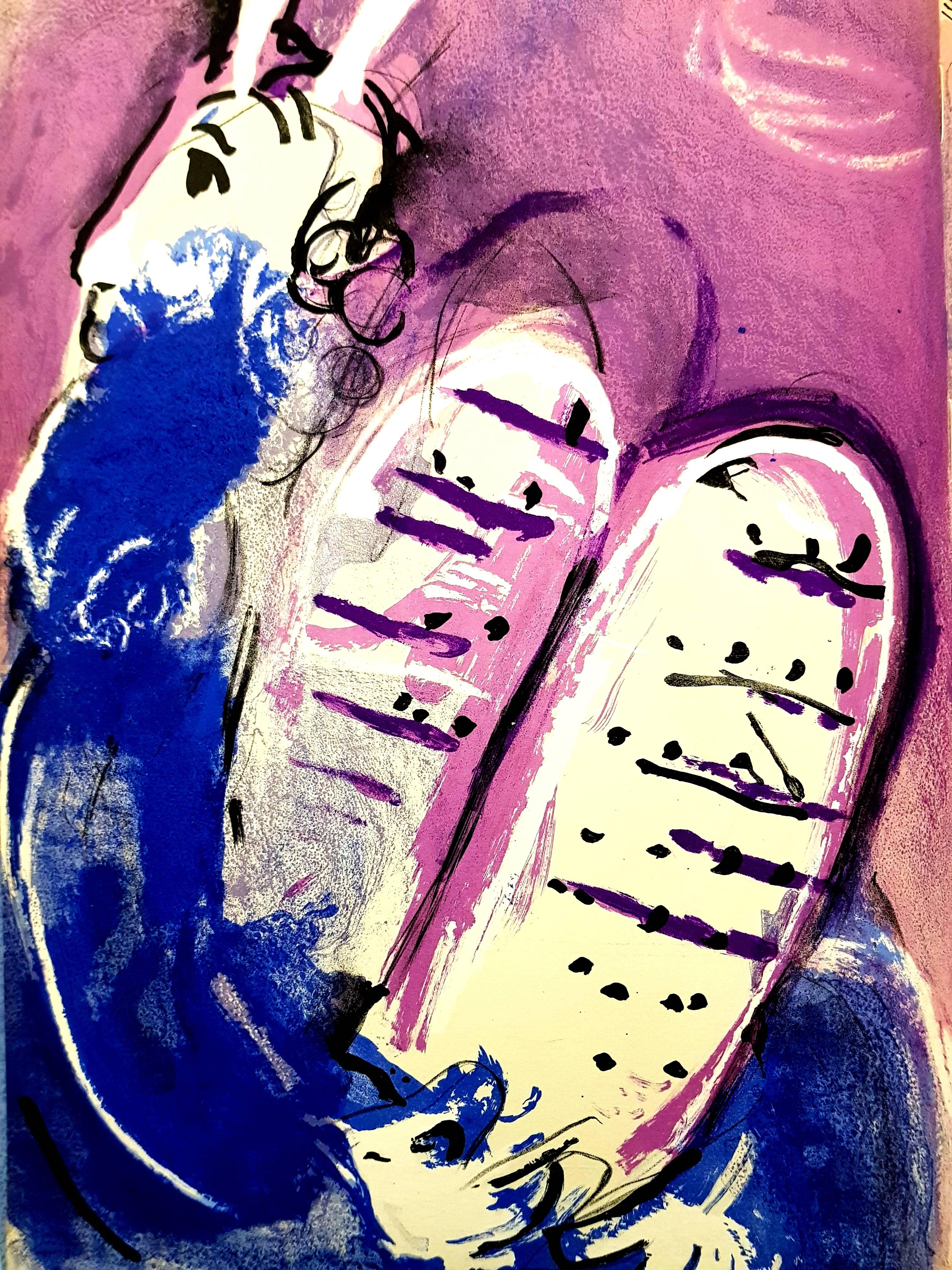Items Similar to Erotic Scene - Lithograph by Albert Marquet - 1920s
Want more images or videos?
Request additional images or videos from the seller
1 of 2
Albert MarquetErotic Scene - Lithograph by Albert Marquet - 1920s1920s
1920s
About the Item
Erotic Scene is a beautiful lithograph on ivory-colored paper, realized in the 1920s by Albert Marquet (Bordeaux, 1875 - Paris,1947).
Monogrammed on the plate on the lower margin. Stamped on the rear "Collection of Pecci-Blunt"
From the Suite L'Académie des Dames, Open Edition in New York of "325".
Good conditions with minor foxing.
Albert Marquet (Bordeaux, 1875 - Paris,1947), French painter and close friend of Henri Matisse, Marquet is often associated with the Fauves ; nevertheless, some critics consider his art closer to that of Édouard Manet and the Impressionists . After 1909, he calmed the chromatic violence of his earliest works, and began using simplified forms and wide brushstrokes; he painted nudes, but most of all fluvial and marine landscapes. Marquet is considered a landscapist who painted scenes of Paris and of the lands he visited. The French painter often incorporated sea or rivers in his artworks, boasting his expert rendering of the silvery quality of light reflecting on water (like in Port de Marseille , 1924).
“ Marquet combined a sure grasp of form, a sensitive and skillful exploitation of dramatic effects of light, and a feeling for color that managed to be sober and rich at the same time. ” In an article of the New York Times of 1953, Howard Devree describes Albert Marquet in these words.
- Creator:Albert Marquet (1875-1947, French)
- Creation Year:1920s
- Dimensions:Height: 9.85 in (25 cm)Width: 13 in (33 cm)Depth: 0.04 in (1 mm)
- Medium:
- Movement & Style:
- Period:
- Framing:Framing Options Available
- Condition:Insurance may be requested by customers as additional service, contact us for more information.
- Gallery Location:Roma, IT
- Reference Number:
Albert Marquet
Albert Marquet was born in Bordeaux in 1875. He studied at the School of Decorative Arts in Paris from 1890-1894, where he became friends with Henri Matisse. He continued his studies at the School of Fine Arts in the studio of Gustave Moreau, from 1895-1898. Albert Marquet paints landscapes and post-impressionist nudes that become more and more colourful and simplified; he expresses himself - following the example of Matisse - in pure tones. At the beginning of the century Modern artist Marquet exhibits in the Parisian Salons (the Salon des Indépendants, the Salon d’Automne) and takes part in numerous art events organised abroad (Russia, the United States, etc.). Marquet meets Dufy and Camoin. He is present at the famous ‘Cage aux Fauves’, that makes a scandal at the Salon d’Automne in 1905; at this time he paints canvases with forms surrounded by black, representing portraits, the Normandy beaches or animated scenes. The artist represents the Seine, often views seen from above and creates variations of themes by changing the time of day and using different lighting. His first solo exhibition is organized in 1907 at the Druet Gallery in Paris. At the beginning of the 1910’s, Marquet paints a series of realistic female nudes. He is unfit for military service in 1914. From the 1920’s until the 1940’s, Albert Marquet takes numerous trips to Europe and Africa that are for him, sources of inspiration in his art, a means for the man to see and learn about other cultures. Albert Marquet’s theme of predilection is his landscapes close to the water (the sea, lake, or river), landscapes that he treats using soft tones that are dominantly grey. Albert Marquet, a sensitive man often well-liked for his modesty, died in 1947 in Paris.
About the Seller
4.9
Platinum Seller
These expertly vetted sellers are 1stDibs' most experienced sellers and are rated highest by our customers.
1stDibs seller since 2017
6,834 sales on 1stDibs
Typical response time: 3 hours
- ShippingRetrieving quote...Ships From: Grasse, France
- Return PolicyA return for this item may be initiated within 14 days of delivery.
More From This SellerView All
- Knieendes Mädchen - Lithograph After Egon SchieleBy (after) Egon SchieleLocated in Roma, ITThis lithograph from the portfolio "Egon Schiele" is a reproduction of "Knieendes Mädchen", an original artwork realized by Egon Schiele in 1914. The portfolio, that includes 10 lith...Category
1990s Modern Figurative Prints
MaterialsLithograph
- Figure - Original Lithograph by L. Sasso - 20th CenturyLocated in Roma, ITFigure is a splendid lithograph engraved by L. Sasso. The state of preservation of the artwork is excellent. Image Container: 40 x 30 cm Image Dimensions: 23.5 x 16 cm Illegible ...Category
20th Century Modern Figurative Prints
MaterialsLithograph
- Nude Figure - Original Lithograph - Mid-20th CenturyLocated in Roma, ITFigure is an original lithograph on paper realized by an anonymous artist of the mid-20th Century. In very good conditions. The artwork created through confident strokes, short and...Category
Mid-20th Century Modern Figurative Prints
MaterialsLithograph
- Female Nude Lying with Scarf - 1910sBy (after) Gustav KlimtLocated in Roma, ITFemale Nude Lying with Scarf is a vintage, beautiful, and rare collotype from “Gustav Klimt: Fünfundzwanzig Handzeichnungen”, a limited-edition collection of 25 monochrome and two-tone collotypes after drawings by Gustav Klimt. Published by Gilhofer and Ranschburg, Vienna, July 1919, just one year after Klimt...Category
1910s Modern Nude Prints
MaterialsLithograph
- La Source dans les Bois - Lithograph by Henri Fantin-Latour - 1898By Henri Fantin-LatourLocated in Roma, ITAutographie (Calcography on paper transfer and Lithograph). Beautiful Proof in sanguine on China paper. In Excellent conditions and full margins. Ref. Cat. Hédiart-Mason n.139; Jo...Category
1890s Modern Figurative Prints
MaterialsLithograph
- Model in the Studio - Lithograph by Felice Casorati - 1946By Felice CasoratiLocated in Roma, ITModella nello studio is a beautiful original lithograph on paper, realized by the Italian master Felice Casorati in 1946. Hand-signed in pencil "F. Casorati" on the lower left margi...Category
1940s Modern Figurative Prints
MaterialsLithograph
You May Also Like
- Formeuse a l'Oreiller (Marie-Therese Walter), Cubist Lithograph by Pablo PicassoBy Pablo PicassoLocated in Long Island City, NYA lithograph from the Marina Picasso Estate Collection after the Pablo Picasso painting "Formeuse a l'Oreiller (Marie-Therese Walter)". The original painting was completed in 1932. ...Category
1980s Modern Figurative Prints
MaterialsLithograph
- Leonor Fini - Duo - Original LithographBy Leonor FiniLocated in Collonge Bellerive, Geneve, CHLeonor Fini - Duo - Original Lithograph The Flowers of Evil 1964 Conditions: excellent Edition: 500 Dimensions: 46 x 34 cm Editions: Le Cercle du Livre Précieux, Paris Unsigned and...Category
1960s Modern Nude Prints
MaterialsLithograph
- Leonor Fini - Road to Death - Original LithographBy Leonor FiniLocated in Collonge Bellerive, Geneve, CHLeonor Fini - Road to Death - Original Lithograph The Flowers of Evil 1964 Conditions: excellent Edition: 500 Dimensions: 46 x 34 cm Editions: Le Cercle du Livre Précieux, Paris Un...Category
1960s Modern Nude Prints
MaterialsLithograph
- Leonor Fini - Lovers - Original LithographBy Leonor FiniLocated in Collonge Bellerive, Geneve, CHLeonor Fini - Lovers - Original Lithograph The Flowers of Evil 1964 Conditions: excellent Edition: 500 Dimensions: 46 x 34 cm Editions: Le Cercle du Livre Précieux, Paris Unsigned ...Category
1960s Modern Nude Prints
MaterialsLithograph
- Marc Chagall - Moses with Tablets of Stone - Original LithographBy Marc ChagallLocated in Collonge Bellerive, Geneve, CHMarc Chagall, Original Lithograph depicting an instant of the Bible. Technique: Original lithograph in colours Year: 1956 Sizes: 35,5 x 26 cm / 14" x 10.2" (sheet) Published by: Éditions de la Revue Verve, Tériade, Paris Printed by: Atelier Mourlot, Paris Documentation / References: Mourlot, F., Chagall Lithograph [II] 1957-1962, A. Sauret, Monte Carlo 1963, nos. 234 and 257 Marc Chagall (born in 1887) Marc Chagall was born in Belarus in 1887 and developed an early interest in art. After studying painting, in 1907 he left Russia for Paris, where he lived in an artist colony on the city’s outskirts. Fusing his own personal, dreamlike imagery with hints of the fauvism and cubism popular in France at the time, Chagall created his most lasting work—including I and the Village (1911)—some of which would be featured in the Salon des Indépendants exhibitions. After returning to Vitebsk for a visit in 1914, the outbreak of WWI trapped Chagall in Russia. He returned to France in 1923 but was forced to flee the country and Nazi persecution during WWII. Finding asylum in the U.S., Chagall became involved in set and costume design before returning to France in 1948. In his later years, he experimented with new art forms and was commissioned to produce numerous large-scale works. Chagall died in St.-Paul-de-Vence in 1985. The Village Marc Chagall was born in a small Hassidic community on the outskirts of Vitebsk, Belarus, on July 7, 1887. His father was a fishmonger, and his mother ran a small sundries shop in the village. As a child, Chagall attended the Jewish elementary school, where he studied Hebrew and the Bible, before later attending the Russian public school. He began to learn the fundamentals of drawing during this time, but perhaps more importantly, he absorbed the world around him, storing away the imagery and themes that would feature largely in most of his later work. At age 19 Chagall enrolled at a private, all-Jewish art school and began his formal education in painting, studying briefly with portrait artist Yehuda Pen. However, he left the school after several months, moving to St. Petersburg in 1907 to study at the Imperial Society for the Protection of Fine Arts. The following year, he enrolled at the Svanseva School, studying with set designer Léon Bakst, whose work had been featured in Sergei Diaghilev's Ballets Russes. This early experience would prove important to Chagall’s later career as well. Despite this formal instruction, and the widespread popularity of realism in Russia at the time, Chagall was already establishing his own personal style, which featured a more dreamlike unreality and the people, places and imagery that were close to his heart. Some examples from this period are his Window Vitebsk (1908) and My Fianceé with Black Gloves (1909), which pictured Bella Rosenfeld, to whom he had recently become engaged. The Beehive Despite his romance with Bella, in 1911 an allowance from Russian parliament member and art patron Maxim Binaver enabled Chagall to move to Paris, France. After settling briefly in the Montparnasse neighborhood, Chagall moved further afield to an artist colony known as La Ruche (“The Beehive”), where he began to work side by side with abstract painters such as Amedeo Modigliani and Fernand Léger as well as the avant-garde poet Guillaume Apollinaire. At their urging, and under the influence of the wildly popular fauvism and cubism, Chagall lightened his palette and pushed his style ever further from reality. I and the Village (1911) and Homage to Apollinaire (1912) are among his early Parisian works, widely considered to be his most successful and representative period. Though his work stood stylistically apart from his cubist contemporaries, from 1912 to 1914 Chagall exhibited several paintings at the annual Salon des Indépendants exhibition, where works by the likes of Juan Gris, Marcel Duchamp and Robert Delaunay were causing a stir in the Paris art world. Chagall’s popularity began to spread beyond La Ruche, and in May 1914 he traveled to Berlin to help organize his first solo exhibition, at Der Sturm Gallery. Chagall remained in the city until the highly acclaimed show opened that June. He then returned to Vitebsk, unaware of the fateful events to come. War, Peace and Revolution In August 1914 the outbreak of World War I precluded Chagall’s plans to return to Paris. The conflict did little to stem the flow of his creative output, however, instead merely giving him direct access to the childhood scenes so essential to his work, as seen in paintings such as Jew in Green (1914) and Over Vitebsk (1914). His paintings from this period also occasionally featured images of the war’s impact on the region, as with Wounded Soldier (1914) and Marching (1915). But despite the hardships of life during wartime, this would also prove to be a joyful period for Chagall. In July 1915 he married Bella, and she gave birth to a daughter, Ida, the following year. Their appearance in works such as Birthday (1915), Bella and Ida by the Window (1917) and several of his “Lovers” paintings give a glimpse of the island of domestic bliss that was Chagall’s amidst the chaos. To avoid military service and stay with his new family, Chagall took a position as a clerk in the Ministry of War Economy in St. Petersburg. While there he began work on his autobiography and also immersed himself in the local art scene, befriending novelist Boris Pasternak, among others. He also exhibited his work in the city and soon gained considerable recognition. That notoriety would prove important in the aftermath of the 1917 Russian Revolution when he was appointed as the Commissar of Fine Arts in Vitebsk. In his new post, Chagall undertook various projects in the region, including the 1919 founding of the Academy of the Arts. Despite these endeavors, differences among his colleagues eventually disillusioned Chagall. In 1920 he relinquished his position and moved his family to Moscow, the post-revolution capital of Russia. In Moscow, Chagall was soon commissioned to create sets and costumes for various productions at the Moscow State Yiddish...Category
1950s Modern Figurative Prints
MaterialsLithograph
- Homme Couchee et Femme Assise, Cubist Lithograph by Pablo PicassoBy Pablo PicassoLocated in Long Island City, NYA lithograph from the Marina Picasso Estate Collection after the Pablo Picasso ink and wash drawing "Homme Couchee et Femme Assise". The original dr...Category
1980s Modern Nude Prints
MaterialsLithograph
